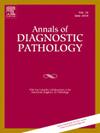Brachyury expression is highly specific for chordoma: A tissue microarray study involving 14,976 cancers from 135 different tumor types and subtypes
IF 1.4
4区 医学
Q3 PATHOLOGY
引用次数: 0
Abstract
Brachyury protein plays a role in defining the midline of bilaterian organisms. Commonly expressed in chordomas, brachyury immunohistochemistry is used to distinguish chordomas from their differential diagnoses. However, brachyury expression has also been described to frequently occur in other cancer entities. To better comprehend the role of brachyury expression in cancer, a tissue microarray containing 14,976 samples from 135 different tumor entities and 608 samples of 76 different normal tissue types were analyzed by immunohistochemistry. Brachyury staining was found in 55 (0.44 %) of the 12,409 interpretable tumor samples, including 37 (0.3 %) with weak, 10 (0.08 %) with moderate, and 8 (0.06 %) with strong positivity. Brachyury staining strongly predominated in chordomas. Of ten chordomas, 7 were strongly and 3 moderately positive. Only 5 of the 134 analyzed further tumor categories showed brachyury staining, 4 of which originated from testicular germ cells. Brachyury positivity occurred in 21.4 % of 42 yolk sac tumors, 15.2 % of 46 embryonal carcinomas, 4.4 % of 562 seminomas, and 2.4 % of 41 teratomas of the testis. Our data support the previously suggested high specificity of brachyury for chordoma detection, and demonstrate that germ cell tumors represent the only additional group of unrelated cancer entities expressing brachyury at a significant level.
Brachyury表达对脊索瘤具有高度特异性:一项组织微阵列研究涉及来自135种不同肿瘤类型和亚型的14,976例癌症
Brachyury蛋白在确定双边生物的中线中起作用。通常在脊索瘤中表达,短鞘免疫组织化学用于区分脊索瘤及其鉴别诊断。然而,短链表达也经常发生在其他癌症实体中。为了更好地理解brachyury表达在癌症中的作用,我们用免疫组织化学方法分析了一个包含135种不同肿瘤实体的14976个样本和76种不同正常组织类型的608个样本的组织芯片。在12409例可解释的肿瘤样本中,55例(0.44%)发现Brachyury染色,其中37例(0.3%)为弱阳性,10例(0.08%)为中度阳性,8例(0.06%)为强阳性。脊索瘤中以短梭色染色为主。10例脊索瘤中,7例为强阳性,3例为中阳性。在134个进一步分析的肿瘤类别中,只有5个显示近周染色,其中4个来自睾丸生殖细胞。42例卵黄囊肿瘤中有21.4%,46例胚胎癌中有15.2%,562例精原细胞瘤中有4.4%,41例畸胎瘤中有2.4%。我们的数据支持先前提出的近缘性对脊索瘤检测的高特异性,并证明生殖细胞肿瘤是唯一一组在显著水平上表达近缘性的不相关癌症实体。
本文章由计算机程序翻译,如有差异,请以英文原文为准。
求助全文
约1分钟内获得全文
求助全文
来源期刊
CiteScore
3.90
自引率
5.00%
发文量
149
审稿时长
26 days
期刊介绍:
A peer-reviewed journal devoted to the publication of articles dealing with traditional morphologic studies using standard diagnostic techniques and stressing clinicopathological correlations and scientific observation of relevance to the daily practice of pathology. Special features include pathologic-radiologic correlations and pathologic-cytologic correlations.

 求助内容:
求助内容: 应助结果提醒方式:
应助结果提醒方式:


